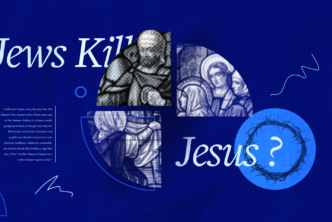“The kingdom of heaven is like…” With these words, Jesus begins on of many parables, arguably his most-used teaching method.
If we don’t know how parables work, we get much of Jesus’ teaching flat wrong.
In this video (transcript below), professor Dan Doriani walks us through how to interpret parables. You can get the full course and many others in New Testament: Advanced Jesus Studies Certificate Program.
*Note: Doriani refers to a modern-day parable he shares earlier in the course to explain a few points about parables. The parable and explanation are reproduced after the video transcript.
How parables work
We want to take as our starting point a fairly famous poem by one of America’s renowned poets, Emily Dickinson. She said this:
Tell all the truth but tell it slant —
Success in Circuit lies
Too bright for our infirm Delight …
The Truth must dazzle gradually
Or every man be blind.
Well, Jesus created parables long before Emily Dickinson gave us that poem, but you understand her point. If you tell the truth straight—we say, “Tell it straight,” but, you know, if you tell it straight, sometimes it’s too much. People can’t handle the truth straight. It’s better to tell the truth slant, to come at it circuitously—“success in circuit lies”—because if you tell the truth, the whole truth, right away, it may dazzle people to blindness instead of allowing them to see.
So Jesus told parables because He knew that. He knew that sometimes we can’t receive the truth right away. It comes better through indirection, through a story. Now, in biblical times, as I said earlier, there were forerunners of parables such as Jesus told, but they were more like illustrations or fables or proverbs or riddles or comparisons. The full-blown parable—like the parable of the Sower, the wheat and the weeds, and others we’ll study later on—was a new creation.
Well, how do parables work? Again, they hide the truth from some, from foes who’ve rejected what they’ve seen, saying they did not see. And so the word’s taken away, but they reveal it to others. To whom? To disciples. To disciples who want to know what it means, who admit “I don’t know what it means” [and ask,] “Jesus, why are you speaking in parables? What does it mean?” And Jesus says, “I’ll tell you. Parables, for disciples, are graphic. They’re memorable. They make us think. Sometimes—you’ll see later—they disarm enemies.”
Listen to this story we hear. And away we go. Kind of like the parable about the monk and the bird and the fox and the cow pie. If that was spoken originally by a president of a university to new profs, people are caught in the story, and then they’re zinged by the sting at the end.
Interpreting parables
Parables are also representational. Characters stand for something, or they represent people or things. Jesus says that. He says He’s the sower. “The Son of Man is the one who sows the seed,” He says in Matt 13, and Satan represents the one who sows bad seed. And, of course, people who don’t listen or listen a little or listen just for a little while or people who deeply listen represent the different kinds of soil.
We’re reminded, then, that we should interpret the parables as ordinarily low-level allegories. Not every last point stands for something, but rather, we have a figure who represents God, sometimes someone who represents someone who resists or opposes God, and then people responding to the Word of God, whether in belief or unbelief or perhaps vacillating between the two.
So then, a parable is more than a moral lesson. It’s not just telling us how to live or describing, in some wisdom, the ways of the world. It’s about the kingdom. It’s about the ways of Jesus. It’s about the Father. When we hear about a farmer, we’re hearing about Jesus and how He sows seed and how He awaits a response. When we read about the wheat and the weeds, we understand that Jesus sows, and His seed grows, and there’s opposition, but it’ll be destroyed.
And Jesus often puts someone in His parables—especially the longer ones, almost always—who represents God the Father or Himself, a king who represents the great King, or a father who represents the ways of God the Father or the ways of Jesus, or a master or a ruler or a leader or someone who does leadership.
Responding to parables
And people bounce off the leader in the parable the way we bounce off or respond to Jesus in real life. Looking ahead, for example, to Luke 14, there’s a parable of a banquet [parable of the Great Banquet], and a host invites all sorts of people, as God the Father invites all sorts of people and, in fact, as Jesus invites all sorts of people to Himself.
Or in Luke 15, there is a father who welcomes lost sons. That’s what God does. God is a father who welcomes lost sinners. In fact, Jesus does the same thing. He welcomes prodigals and also self-righteous people when they come back to Him. Or, just one more, the parable of the Good Samaritan. There is a good Samaritan who comes and rescues someone who’s been beaten and left for dead. Well, isn’t that what Jesus does for us? He comes along unexpectedly when we’re as good as dead and rescues us.
So we look for calls to action, calls to faith, to response in ourselves, but we don’t just look for ourselves and the things we ought to do. We look for what God is doing, what Christ is doing. We’re not responding to commands. We’re responding to the one who gives commands, our Lord.
Explore more Mobile Ed courses.
***
The parable of the bird and the cow pie
In the mountainous regions of northern Italy, there was a monastery that overlooked a small subalpine village. Every day, early in the morning, a monk wended his way down a footpath to say Mass in the village church. One cold morning in the spring, he spied a small bird by the side of the path shivering with cold, [and] nearly expired. He was a kindly monk, and so, without hesitation, he picked the bird up, examined it, and then, lacking any alternative, put it inside his habit next to his warm body.
By the time he’d reached the piazza in front of the church, the little bird had revived sufficiently that it was wriggling about rather briskly under his garment. And he realized it wouldn’t do to bring the bird with him into the church. Bells began to chime, [it was] time for the services to begin, and he stood there wondering what to do. He looked around and noticed a great steaming cow pie providentially placed there by a dairy cow departing for the meadows beyond the village.
Gently but firmly, he set the bird down into this warm and gelatinous mixture and went into the church. The bird was revived still further by the warmth of the cow pie, so much so that it began to sing. An old fox patrolling over the stone wall of the church heard it, hopped into the piazza quick as a flash, snapped the bird out of the cow pie, and ate it.
The meaning of the parable
That’s the parable. Perhaps the ending is a bit unexpected to you. Perhaps you wonder what it means. Well, the person who told the story was kind enough to tell us what the significance is. He said there were three points to the story. First, the one who puts you into it is not necessarily your enemy. Second, the one who gets you out of it is not necessarily your friend. And third, if you find yourself up to your beak in the stuff, it’s best to keep that beak shut. Thus, the parable.
The parable of the bird and the cow pie illumines aspects of Jesus’ parables. We might say the parable of the bird and the cow pie is kind of like some of Jesus’ parables.
The funny side
First of all, some of Jesus’ parables are like that one. They are a bit like jokes. They catch us up with something surprising, something startling [or] unpleasant, something we might laugh at. At the end, there is a punchline. There are also illustrations. They’re memorable. They engage the imagination. We can easily see a bird in a cow pie. We can imagine a fox, a monk, and all the rest.
A deeper meaning
So they’re like jokes, they’re like illustrations, but they’re also like allegories. We have the sense when we hear this parable that there’s something more going on than just a story about birds and monks and foxes and cow pies. There’s some reason to tell the story, and so it is with Jesus’ parables. There’s a surface meaning that is not by any means the deepest or the final meaning. They make us wonder, what’s this all about?
Is the tale of the bird and the cow pie about the danger of false friends, about the people that seem to help us and care about us but really are quite careless, like that monk? Perhaps it’s a tale about unintended consequences. The monk meant to help. The monk meant to further revive the bird, but alas, he wasn’t thinking. He didn’t consider all the possible dangers and [that] there are careless people and we bear the consequences. Maybe it’s something dark along those lines.
The importance of context
In fact, context is always vital to the right interpretation of Jesus’ parables, and so it is in this case as well. Without any context, we’d think to ourselves, “Well, this is a story about the ironies of life. People mean to do good. In fact, they do you harm. What looks like a friend is, in fact, an enemy.” And so forth.
As I received this parable, it was in this context: a president of a university told this story to a gathering of new professors. In that setting, the parable goes from a joke to a veiled threat: “If you want to survive, keep your mouth shut.” So we can see that, in this case, the parable comes to have a disturbing edge because of the context. And so it is with Jesus’ parables. They are often disturbing, not in the sense of a threat like this parable, but they upset sensibilities. They surprise people. They confront people at times, especially if confrontation is in the air.
And, of course, the truth is that confrontation was almost constantly in the air because Jesus upset the ruling authorities. When He began to teach in parables—when He began to teach in parable after parable—it was indeed a time of great conflict and conflict between Jesus and His Jewish contemporaries.





